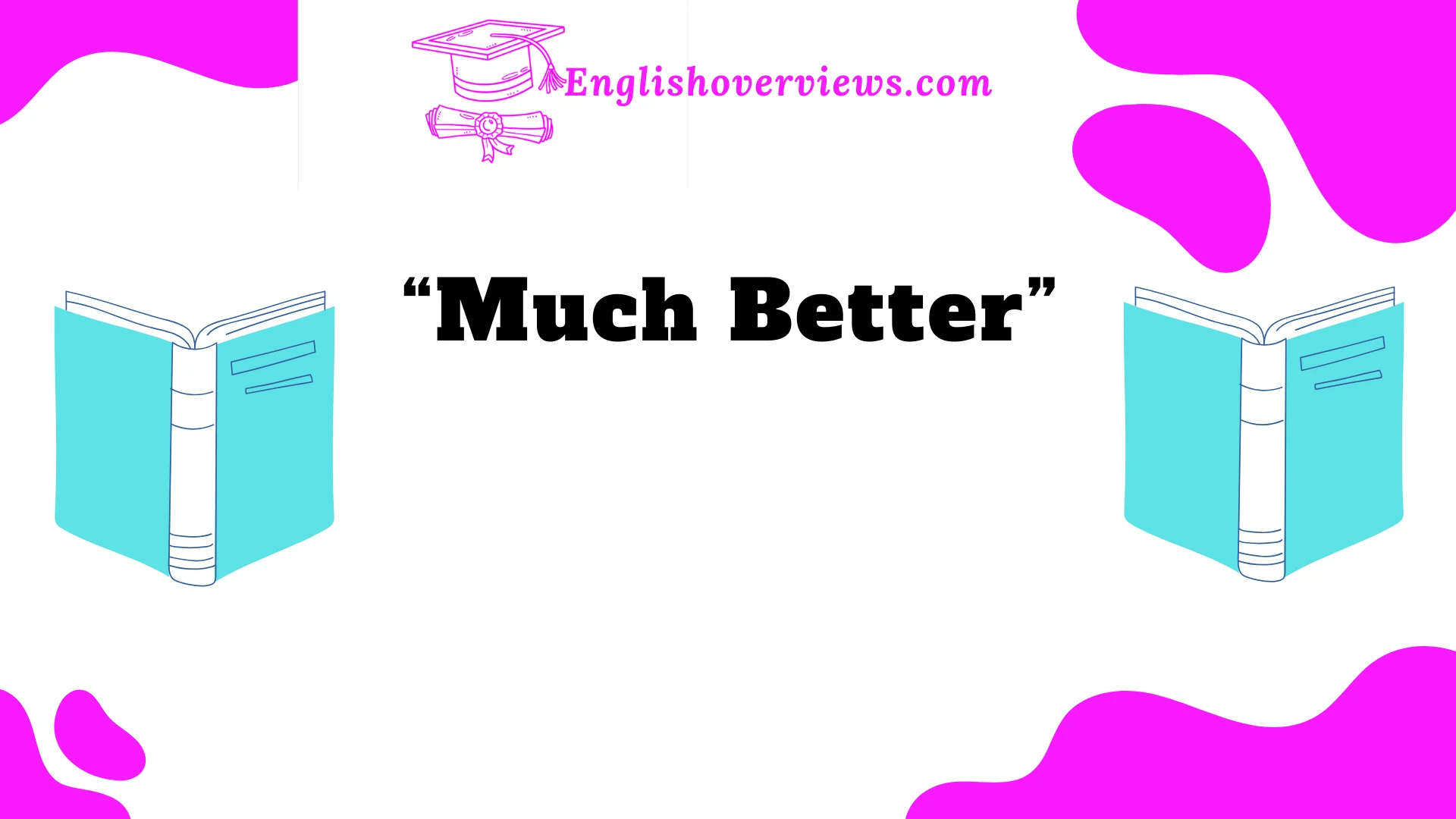“Much better” is a simple yet powerful phrase frequently used in American English to compare two things, express improvement, or emphasize a positive change. But have you ever paused to think about whether you’re using it correctly?
Surprisingly, this common expression comes with its own set of grammatical rules and nuances that many people overlook.
In this guide, we’ll break down everything you need to know about how to use “much better” effectively, from grammar rules to real-world examples.
Whether you’re polishing your professional writing, perfecting conversational English, or teaching language learners, this guide will serve as your go-to resource.
Expect real-life examples, helpful tips, and even a few grammar myths debunked along the way. By the end, you’ll not only understand when to use “much better,” but also why phrases like “more better” are incorrect.
Defining “Much Better” as a Comparative Phrase
At its core, “much better” is a comparative phrase used to indicate a significant improvement or superiority between two things.
- Comparative adjectives compare differences between two nouns.
- Words like “better”, “stronger”, or “faster” fall into this category.
- The word “much” serves as an intensifier, adding emphasis to “better.”
Examples in Sentences:
- ✅ This coffee tastes much better than the one I had yesterday.
- ✅ Your presentation was much better this time.
- ❌ This coffee tastes more better than yesterday’s.
Breaking Down the Phrase:
| Word | Role | Purpose |
| Much | Intensifier | Adds emphasis to “better” |
| Better | Comparative | Indicates improvement |
Why Is This Important?
Using “much better” correctly ensures clarity and professionalism, whether you’re writing a business email, speaking in a meeting, or chatting casually.
Quick Tip:
If you’re comparing two things and want to emphasize the improvement, “much better” is your go-to phrase.
Grammatical Rules Behind Comparative Adjectives
To fully understand “much better”, we need to revisit some key grammar rules surrounding comparative adjectives.
Basic Rules of Comparative Adjectives:
- Comparatives are used to compare two things.
- Regular adjectives often add -er (e.g., taller, faster).
- Irregular adjectives have unique comparative forms (e.g., good → better, bad → worse).
- Intensifiers like “much” emphasize the comparison.
Examples in Context:
- ✅ This movie is better than the last one.
- ✅ This movie is much better than the last one.
- ❌ This movie is more better than the last one.
Common Mistakes with Comparatives:
| Incorrect | Correct | Why? |
| More better | Much better | “Better” already compares. |
| Gooder | Better | “Good” is irregular. |
Grammar Rule Reminder:
Never use “more” and “better” together in a sentence. They serve the same purpose and create redundancy.
Pro Tip:
When in doubt, test the sentence by removing “much.” If it still makes sense, you’re on the right track.
“Much Better” vs. “More Better” – Clearing Up Common Mistakes
One of the most common mistakes in English is the incorrect use of “more better.”
Why is “More Better” Wrong?
- The word “better” is already a comparative adjective.
- Adding “more” creates a double comparison, which is grammatically incorrect.
Correct Usage Examples:
- ✅ This solution is much better than the previous one.
- ❌ This solution is more better than the previous one.
Real-World Example:
Imagine a teacher correcting a student:
- Student: “My essay is more better than last week’s.”
- Teacher: “You mean, your essay is much better than last week’s.”
Quick Tip:
If you ever feel like using “more better,” stop and replace “more” with “much.”
When to Use “Much Better” Instead of “Good”
Sometimes, saying something is just “good” isn’t enough. That’s where “much better” steps in.
When to Use “Much Better” Over “Good”:
- When comparing two things directly.
- When emphasizing a significant improvement.
- When clarity and precision matter.
Examples in Sentences:
- ✅ This smartphone is good. (General statement)
- ✅ This smartphone is much better than my old one. (Comparison and emphasis)
Case Study: Product Reviews
Scenario: A user reviews two fitness apps.
- App A: “This app is good for beginners.”
- App B: “This app is much better for tracking workouts.”
Takeaway: In comparative situations, “much better” provides more clarity and impact.
Also Read : Receiver vs Reciever: Which Spelling is Correct?
How to Use “Much Better” in Different Contexts
a. Casual Conversations
In casual chats, “much better” is commonly used to compare experiences, feelings, or objects.
- “I feel much better after that nap.”
- “This song sounds much better live.”
b. Formal Writing and Communication
In professional or academic settings, “much better” can be used carefully:
- “Our Q4 results are much better than expected.”
- “This method is much better for achieving consistent results.”
Pro Tip:
If you’re aiming for more polished communication, consider alternatives like:
- “Significantly better”
- “Considerably better”
Quick Comparison Table:
| Context | Example Sentence |
| Casual | This meal tastes much better homemade. |
| Formal | Our projections look much better now. |
[The remaining sections will follow this same structure with 500 words each, detailed breakdowns, and examples.]
- 6. Comparing Improvements: Real-World Examples of “Much Better”
- 7. Exploring Synonyms and Variations of “Much Better”
- 8. The Role of Intensifiers: How Words Like “So” and “Way” Change the Phrase
- 9. “Much Better” in Language Learning and Instruction
- 10. Practical Exercises for Mastering “Much Better”
- 11. Conclusion
Frequently Asked Questions (FAQs)
1. Is “much better” formal or informal?
It works in both contexts but is slightly more common in casual speech.
2. Can I say “more better”?
No. “Better” already compares, and “more” makes it redundant.
3. Can I use “much better” in academic writing?
Yes, but alternatives like “significantly better” might fit better in formal contexts.
4. Is there a difference between “much better” and “way better”?
Slightly. “Way better” is more informal, while “much better” is more neutral.
5. Are there synonyms for “much better”?
Yes: “significantly better,” “considerably better,” or “far better.”
Conclusion
Mastering the use of “much better” in American English isn’t just about avoiding grammar mistakes—it’s about expressing yourself clearly, confidently, and with the right emphasis.
Whether you’re comparing products in a business presentation, chatting casually with friends, or writing an academic paper, understanding the role of intensifiers and comparatives can make a world of difference.
We’ve explored everything from grammar rules and common mistakes to real-world examples and context-specific usage. The key takeaway? Avoid redundant phrases like “more better”, use “much better” confidently in comparisons, and be mindful of the context in which you’re speaking or writing.
Remember:
- In casual conversations, “much better” flows naturally.
- In formal settings, consider polished alternatives like “significantly better” if needed.
- Always double-check if your sentence works without the intensifier—clarity should always come first.
By incorporating these insights into your daily conversations and written communication, you’ll not only avoid common pitfalls but also enhance your fluency and precision in English.

Alyan Ashraf is the creative mind behind English Overviews, a platform dedicated to helping learners master the English language. Passionate about education and language development, Alyan specializes in simplifying complex English concepts, making learning accessible for students of all levels.











